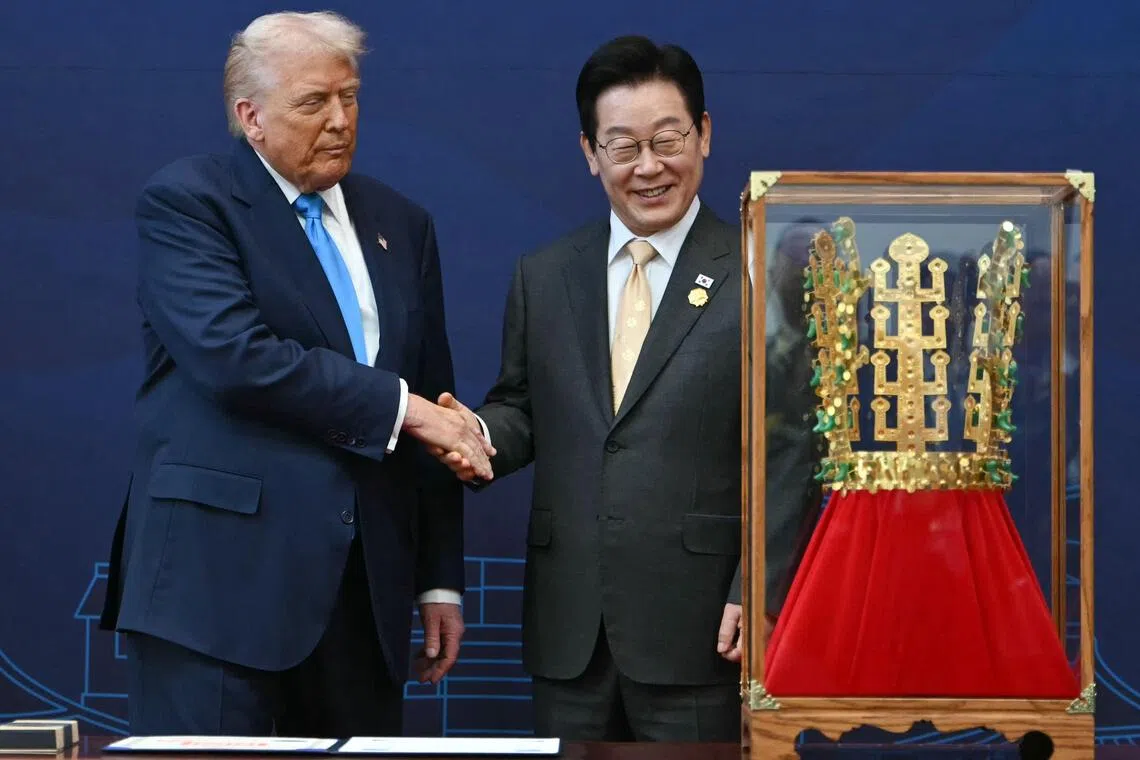Diplomacy of gifts: Inside South Korean President Lee Jae Myung’s symbolic summit strategy
Sign up now: Get ST's newsletters delivered to your inbox

US President Donald Trump (left) was given a replica of a thousand-year-old crown by South Korean President Lee Jae Myung during a high-honour presentation ceremony.
PHOTO: AFP
Follow topic:
SEOUL – Most people won’t turn down a gift and a well-chosen present has the quiet power to warm a room, soften the tone and open the heart.
In diplomacy, where every gesture can tilt the balance of trust, gifts do more than mark an occasion – they carry meaning, signal intention and, at times, attempt persuasion.
At the 2025 Apec Summit, South Korean President Lee Jae Myung turned his attention to that power.
From a model of a thousand-year-old royal crown to a handcrafted mother-of-pearl tray, Mr Lee’s “gift diplomacy” became as noteworthy as the summit’s policy discussions, offering a glimpse into the art – and stakes – of symbolic exchange between world leaders.
Crown for Trump: Calculated gesture?
Among the most symbolic of Mr Lee’s offerings was the replica of the golden Silla Kingdom crown
For Mr Trump, a figure who has long prized spectacle, status and symbols of power, the gift was a strategic olive branch.
“It’s not the physical value of the gift but the symbolism that matters in diplomacy,” said Dr Kim Tae-hyung, a political science professor at Soongsil University.
“The gold crown is a nod to Mr Trump’s taste for grandeur and self-importance. Mr Lee understood that Mr Trump sees every diplomatic encounter as a transaction – something that must benefit his image.”
Dr Kim argued that the gesture was more than ceremonial; it was tactical.
He said: “Mr Lee knew this wasn’t a traditional diplomatic meeting. Mr Trump is not a traditional diplomatic figure.
“Unlike previous administrations, where gifts were mostly formalities, this time the gesture was calculated to appeal to Mr Trump’s ego and to open the door for deeper discussions.”
The era when diplomacy was guided by quiet courtesy and respect for protocol is over – at least where Mr Trump is concerned, Dr Kim added.
“Today’s diplomacy with Mr Trump isn’t traditional diplomacy,” said Dr Kim. “It’s not about stable alliances or multilateral strategies. It’s about understanding what he wants and giving it to him before he asks for it.”
“It’s not ‘America First’, more of ‘Trump First’,” said Dr Kim.
While Mr Trump has repeatedly campaigned on the slogan of American revitalisation, much of his foreign policy can be traced not to geopolitical logic, but to his own personal pride and emotional triggers, the professor said.
“Mr Lee took a step others hadn’t: He anticipated Mr Trump’s need to be flattered, to feel singular. The gift wasn’t just respectful; it was a psychological key.”
And perhaps, it worked. A previous South Korea-US summit in August had produced uncertainty, with little clarity on security cooperation or trade protections.
“This time was different,” Dr Kim said. “Mr Lee had one chance at Apec to shift the energy and his approach bore fruit.”
In return, Mr Trump gifted Mr Lee a baseball bat signed by Washington Nationals rookie Joey Crouse — an offering that sparked criticism in South Korea.
“The crown evokes 1,500 years of Korean history. The bat was signed by a player who’s barely known in his own league,” said Dr Shin Yul, political scientist at Myongji University.
“It’s a stark reminder of South Korea’s diplomatic position – in need of American goodwill but not always reciprocated with the same weight or respect. And yet, under the current political climate, it is not a complaint South Korea can voice without risk.”
Game of Go with Xi Jinping
For Chinese President Xi Jinping, who made his first state visit to South Korea in 11 years, Mr Lee presented a different kind of treasure: a Go board
The wood it was crafted from, cherished in both countries for its tight grain and elegant ageing, is a top-tier material for the ancient game.
It was chosen with intention. Both Mr Lee and Mr Xi are known to appreciate Go, and the game itself is an enduring symbol of strategy, patience and equilibrium.
“It was a meaningful gesture, not only because both leaders enjoy Go,” the presidential office said.
“But because South Korea and China have long shared cultural space in the game and, like the game’s black-and-white stones, must continue to strike a balance in their political partnership.”
Mr Lee also gifted Mr Xi a mother-of-pearl lacquer tray, made with a technique passed down since the Goryeo Kingdom (918 to 1392). The glinting abalone shards were intended to evoke the “long, enduring ties” between the two countries, officials added.
Mr Xi responded with two Xiaomi smartphones — a symbolic pivot from China’s traditional silk and tea presentations.
The choice seemed to declare modernity and technical autonomy, even as the US and allies continue to blacklist Chinese telecom products. Mr Lee’s half-joking reply – “How’s the security on these?” – was met with laughter, but analysts saw a deeper thread.
“Mr Xi’s gift says, ‘trust our technology’,” Dr Shin noted.
“In an age when energy grids, satellite networks and social platforms hinge on digital systems, the message isn’t lost. The diplomacy is encoded in the device itself: We are sophisticated and reliable.”
With Japan’s newly appointed Prime Minister Sanae Takaichi, Mr Lee took a lighter, cultural approach, presenting Korean seaweed snacks and skincare products.
“Diplomacy isn’t only about treaties and defence. Relationships also need familiarity, humour and moments of ease. Gifts that, in their own quiet way, suggest that diplomacy is sometimes played not in words but in symbols,” Dr Kim said. THE KOREA HERALD/ASIA NEWS NETWORK

